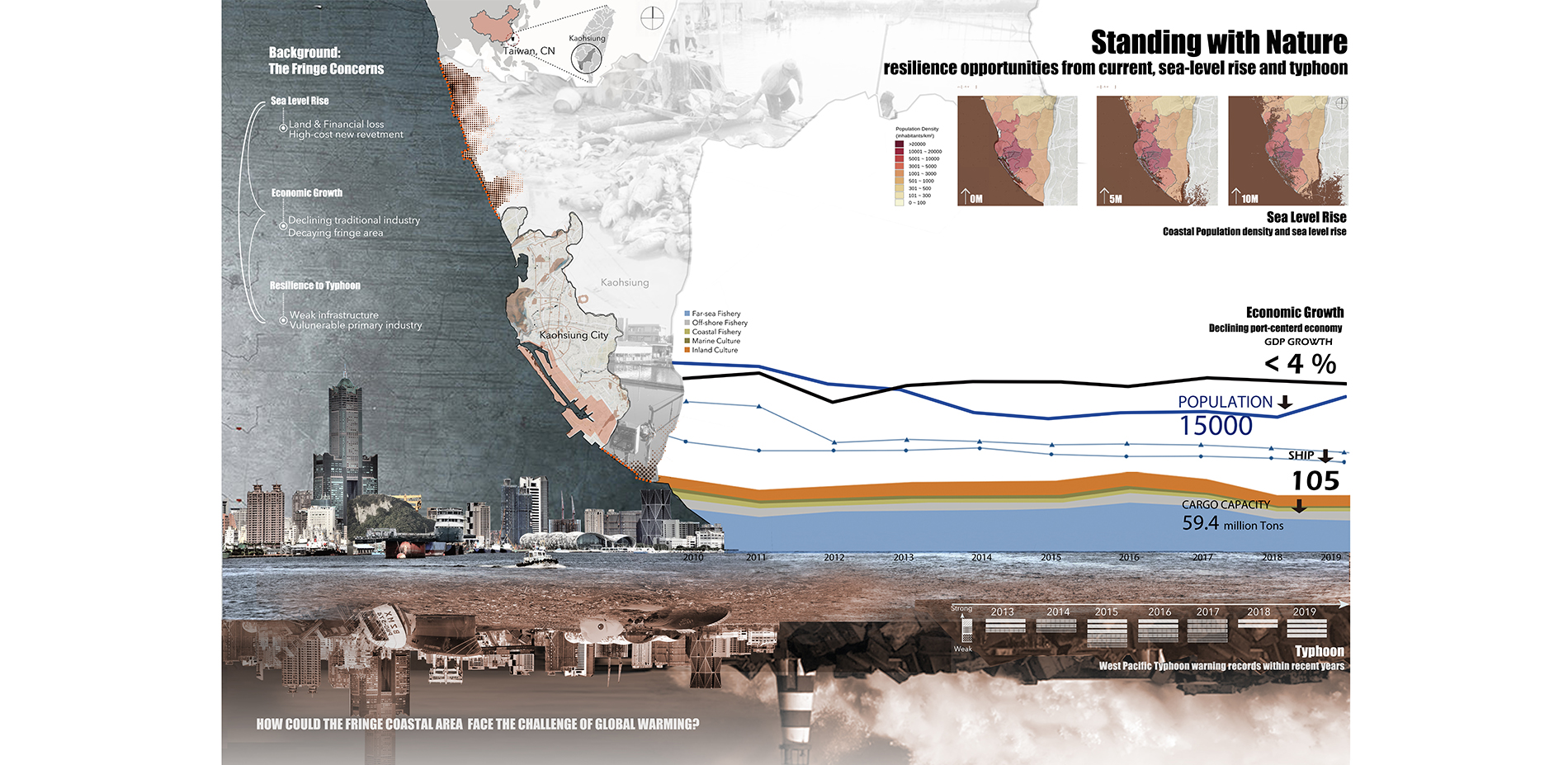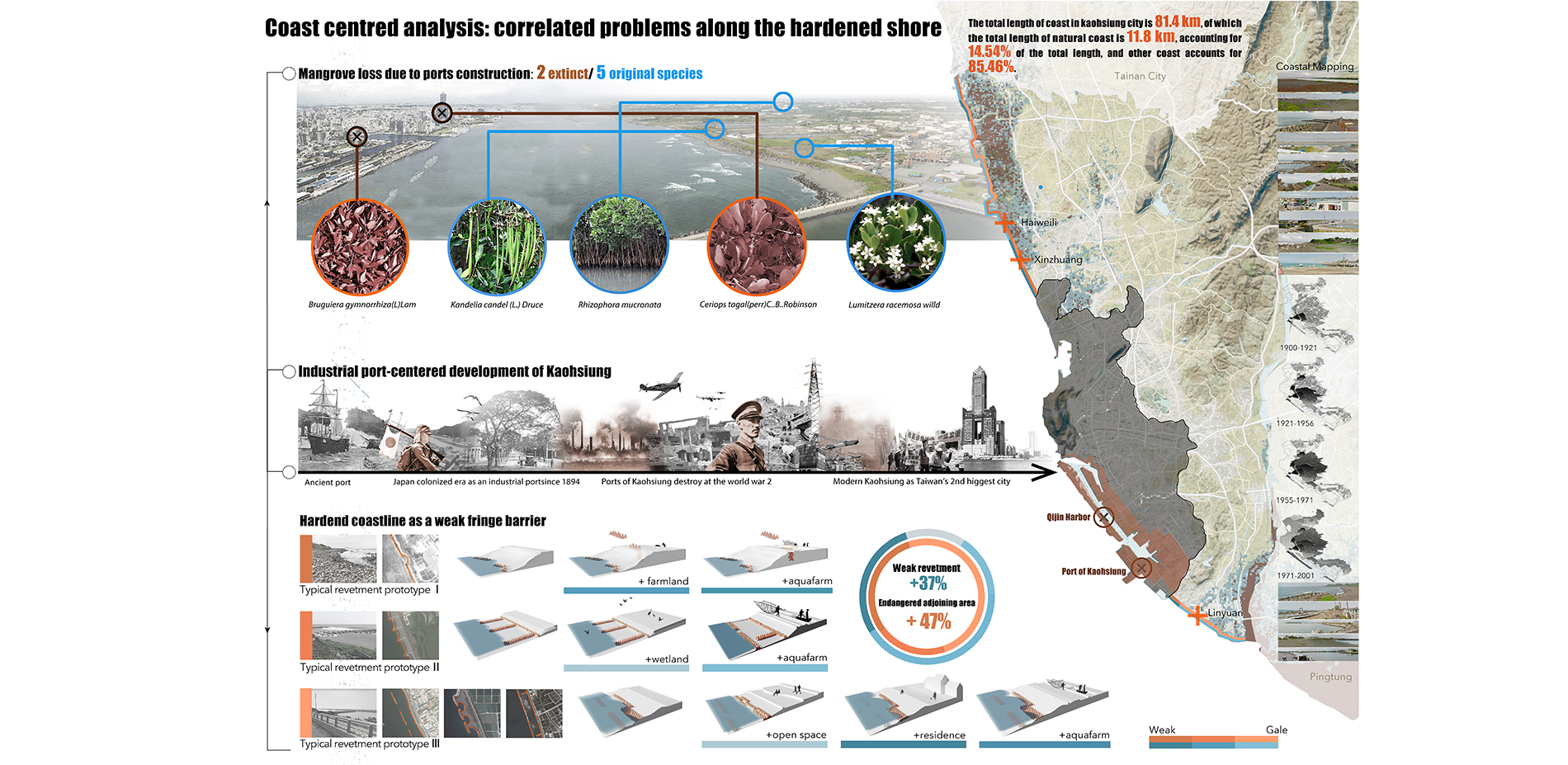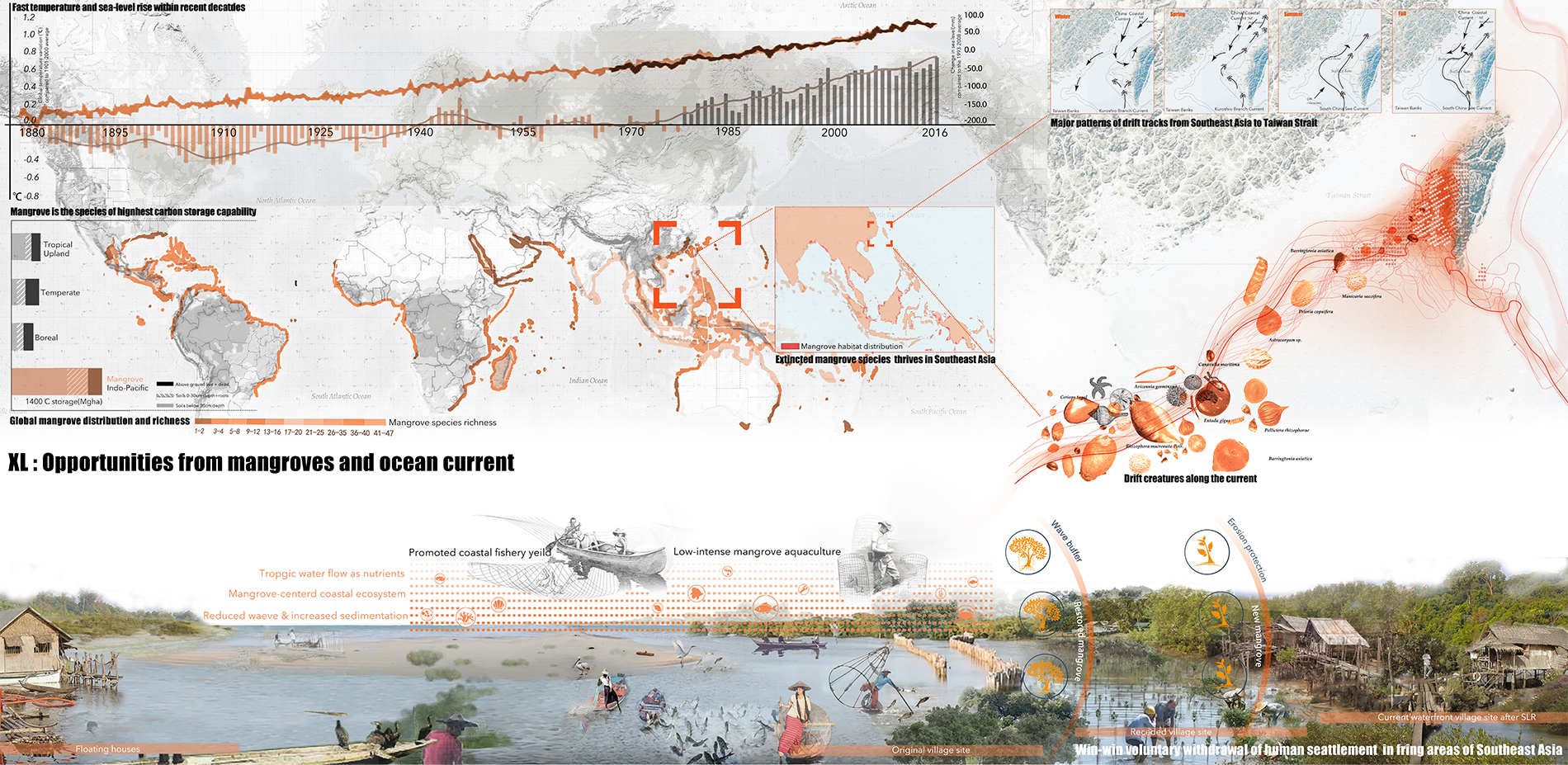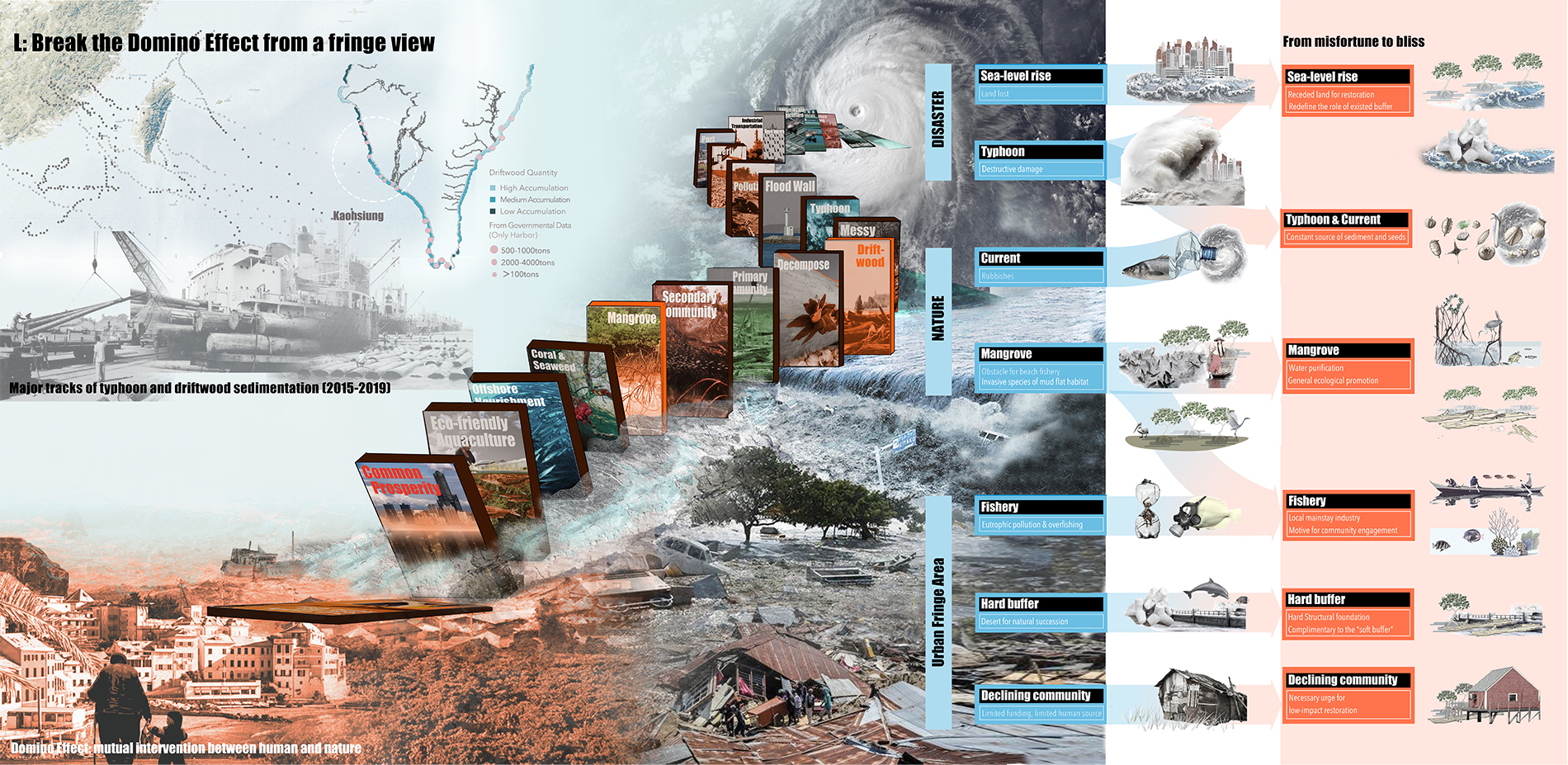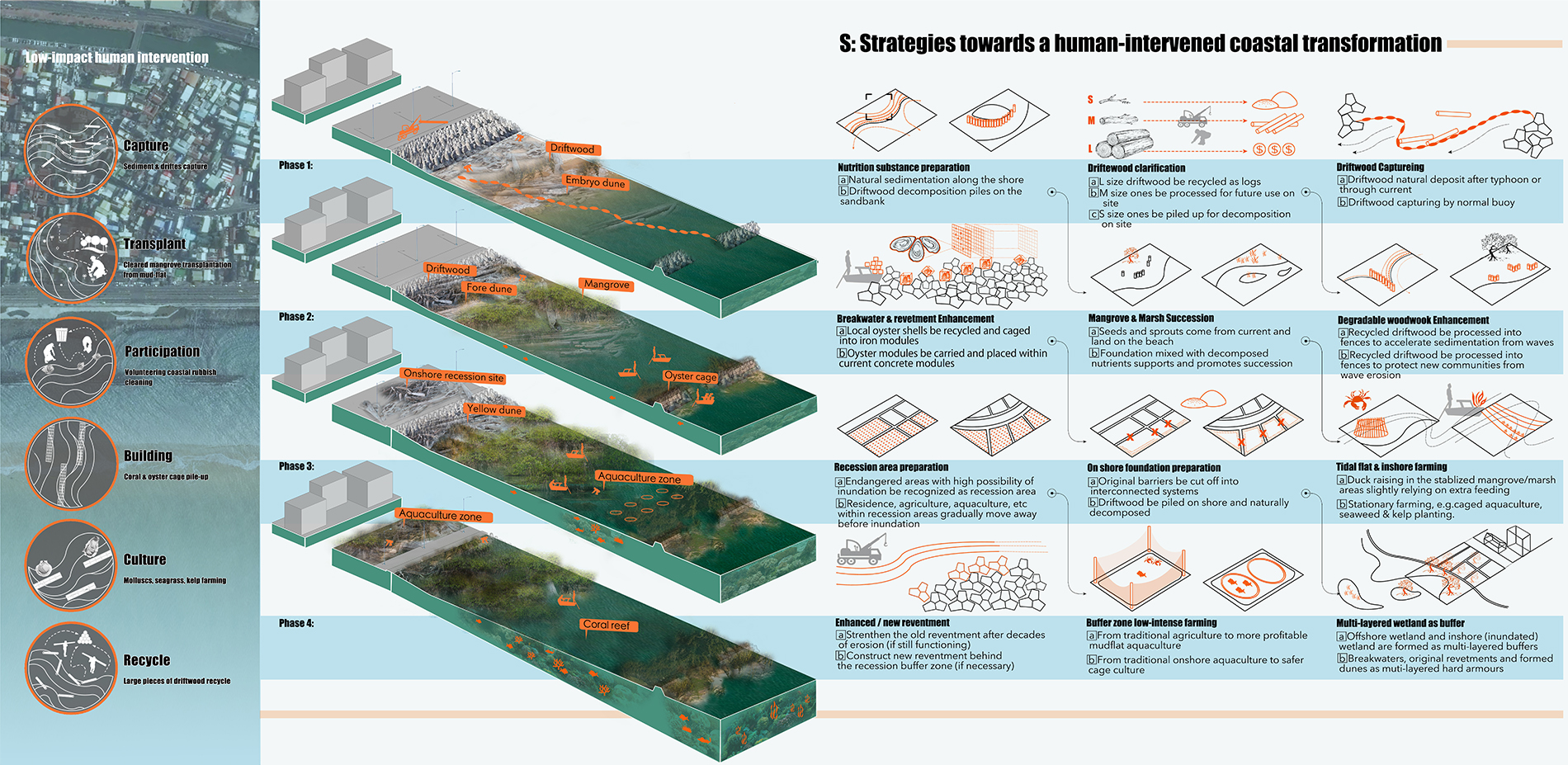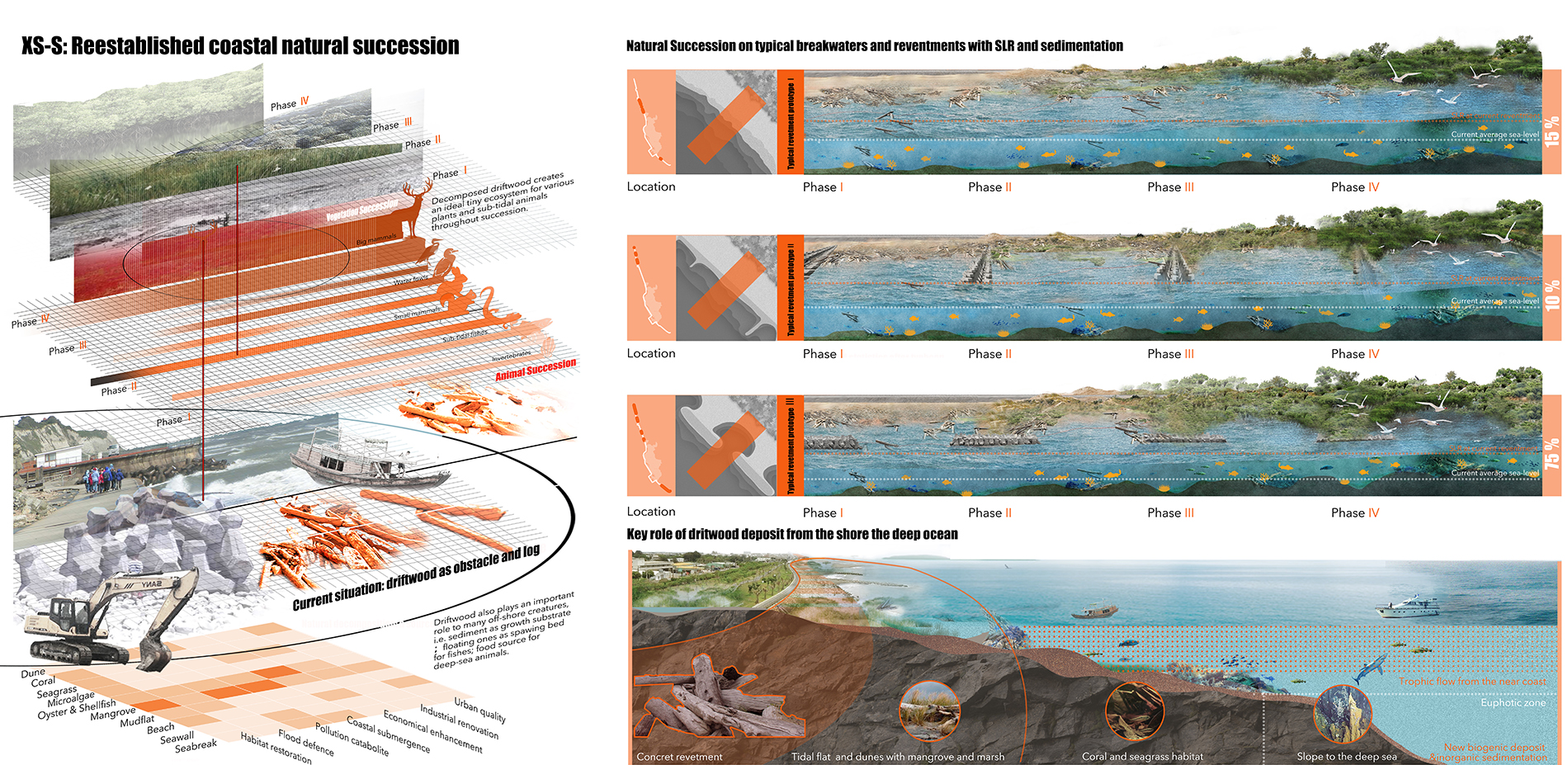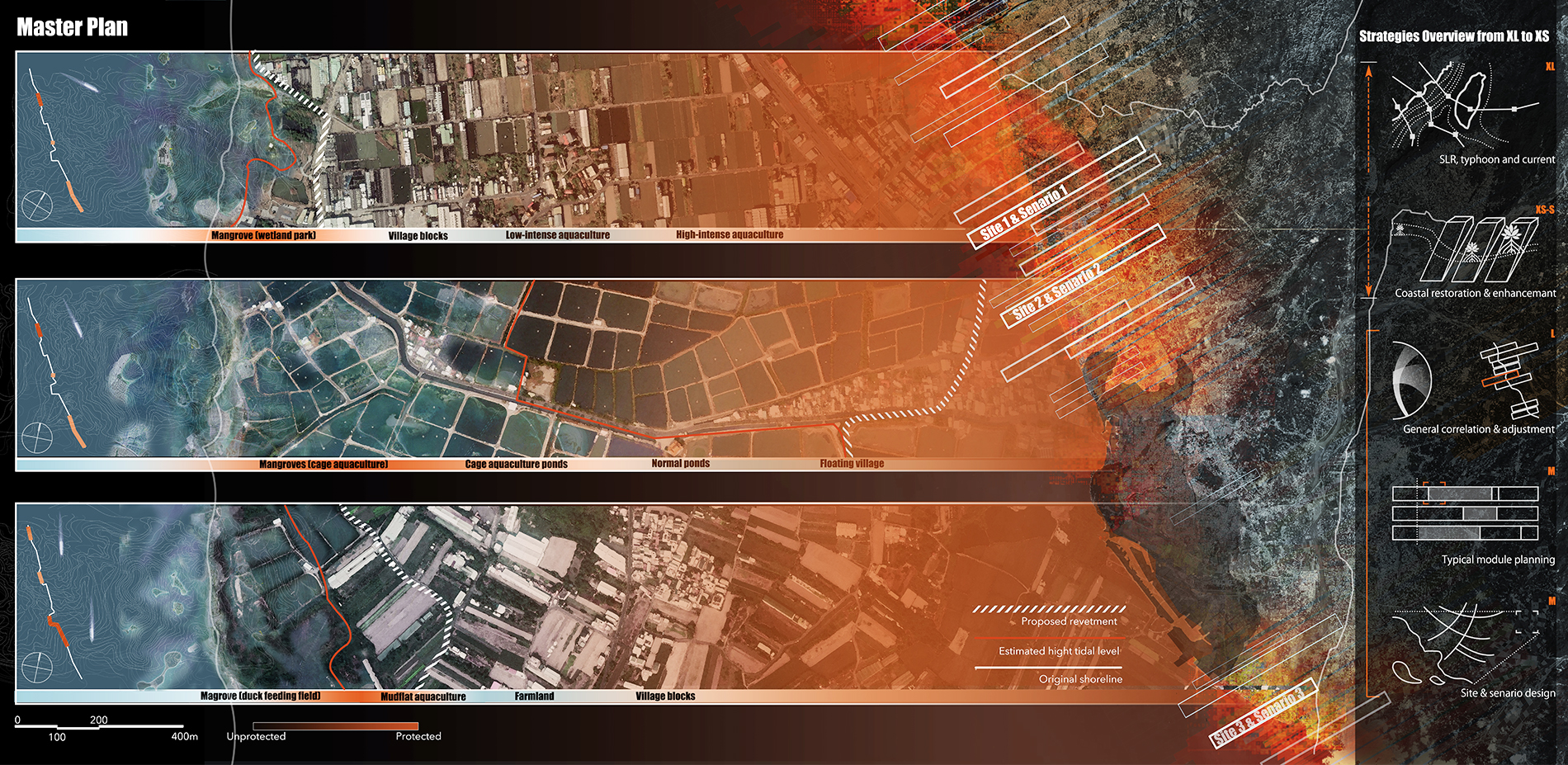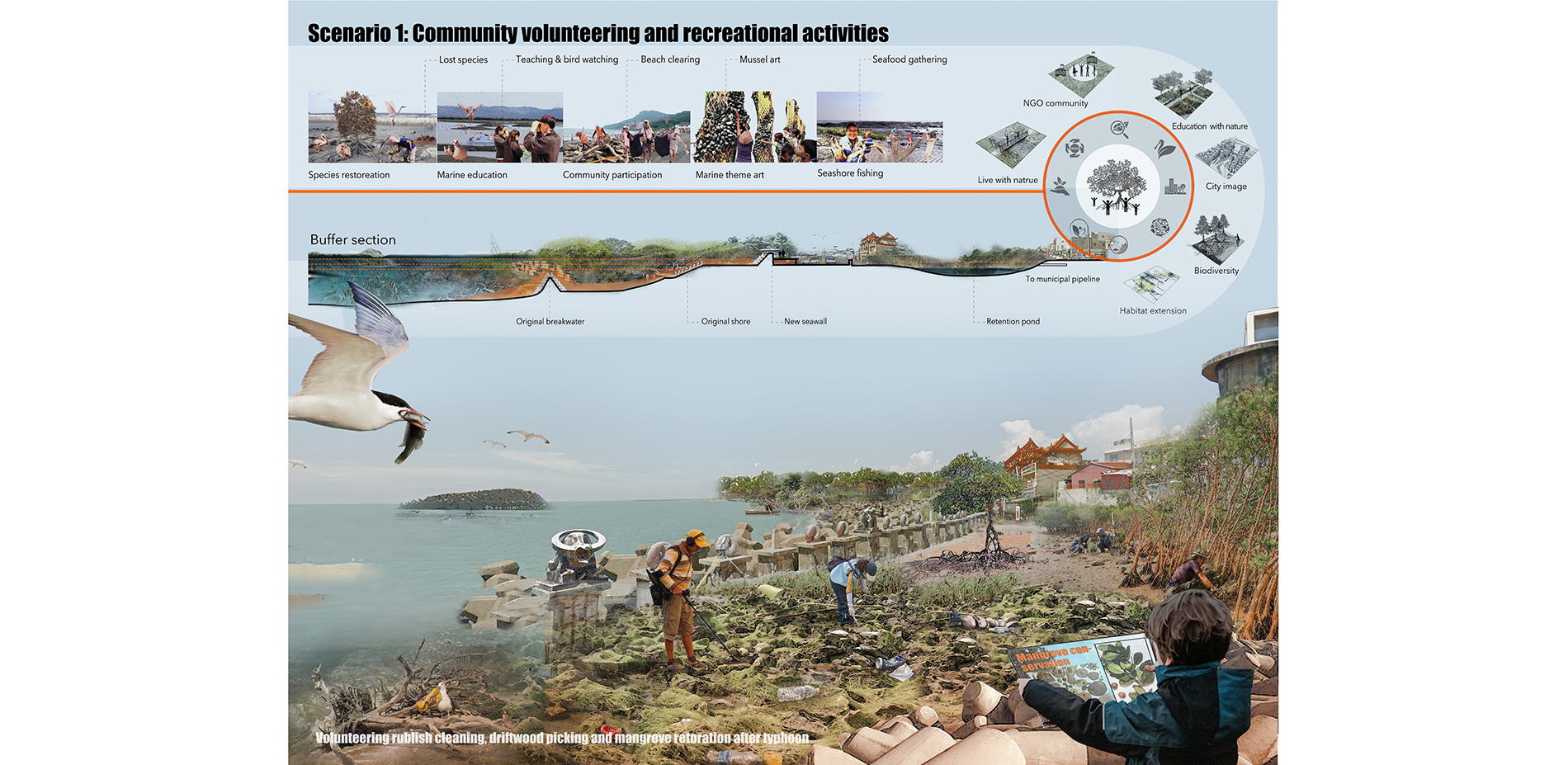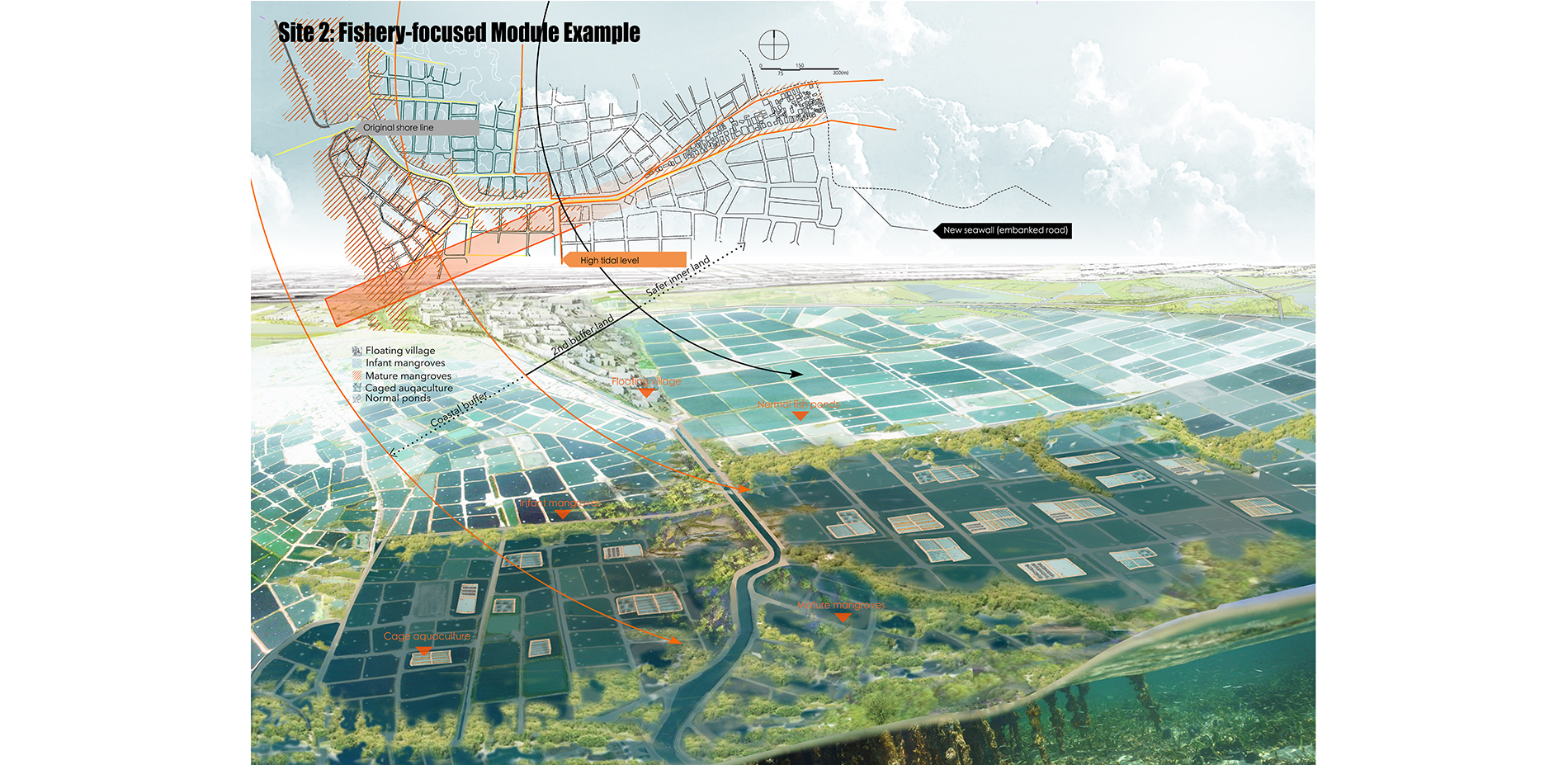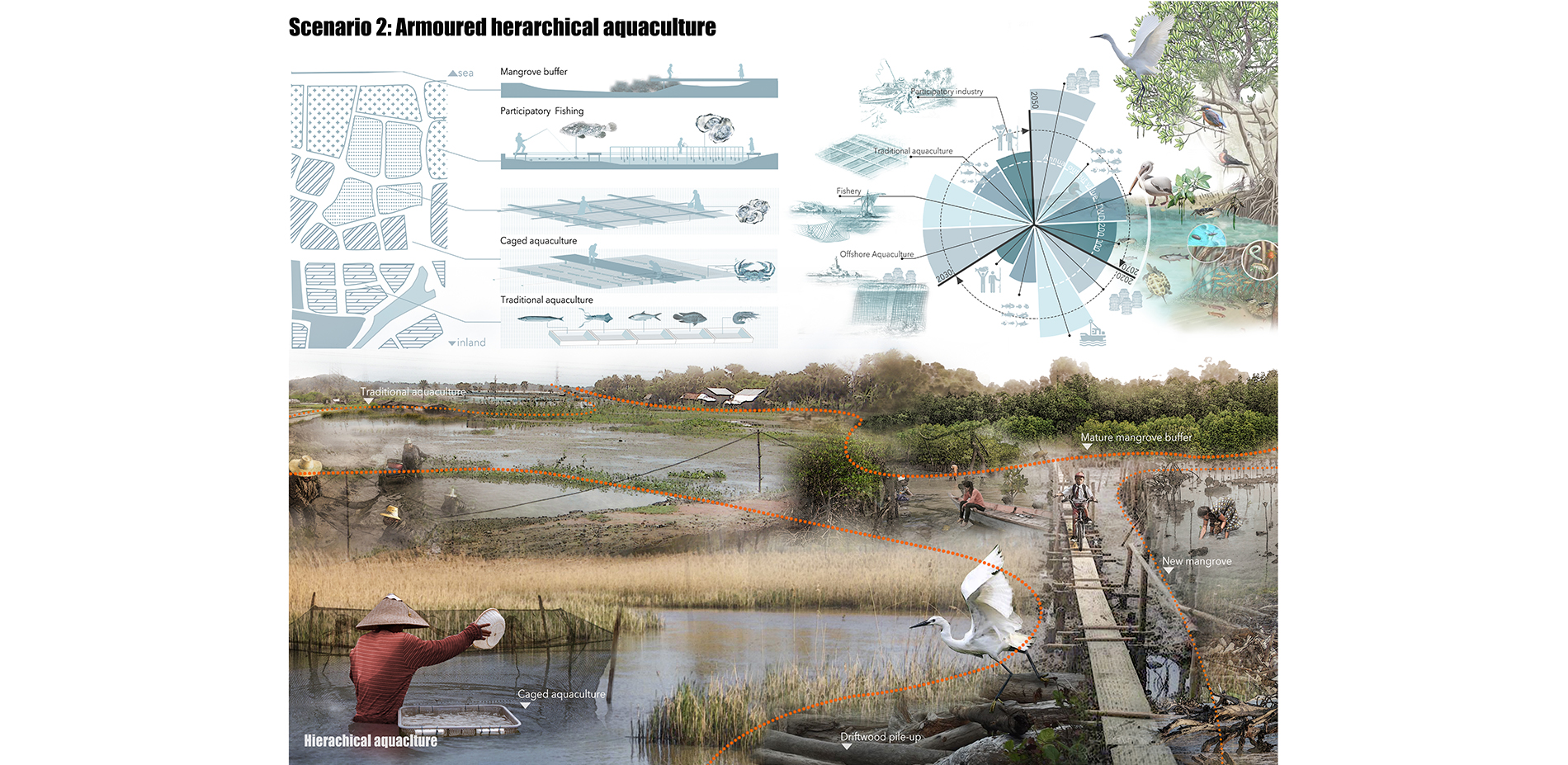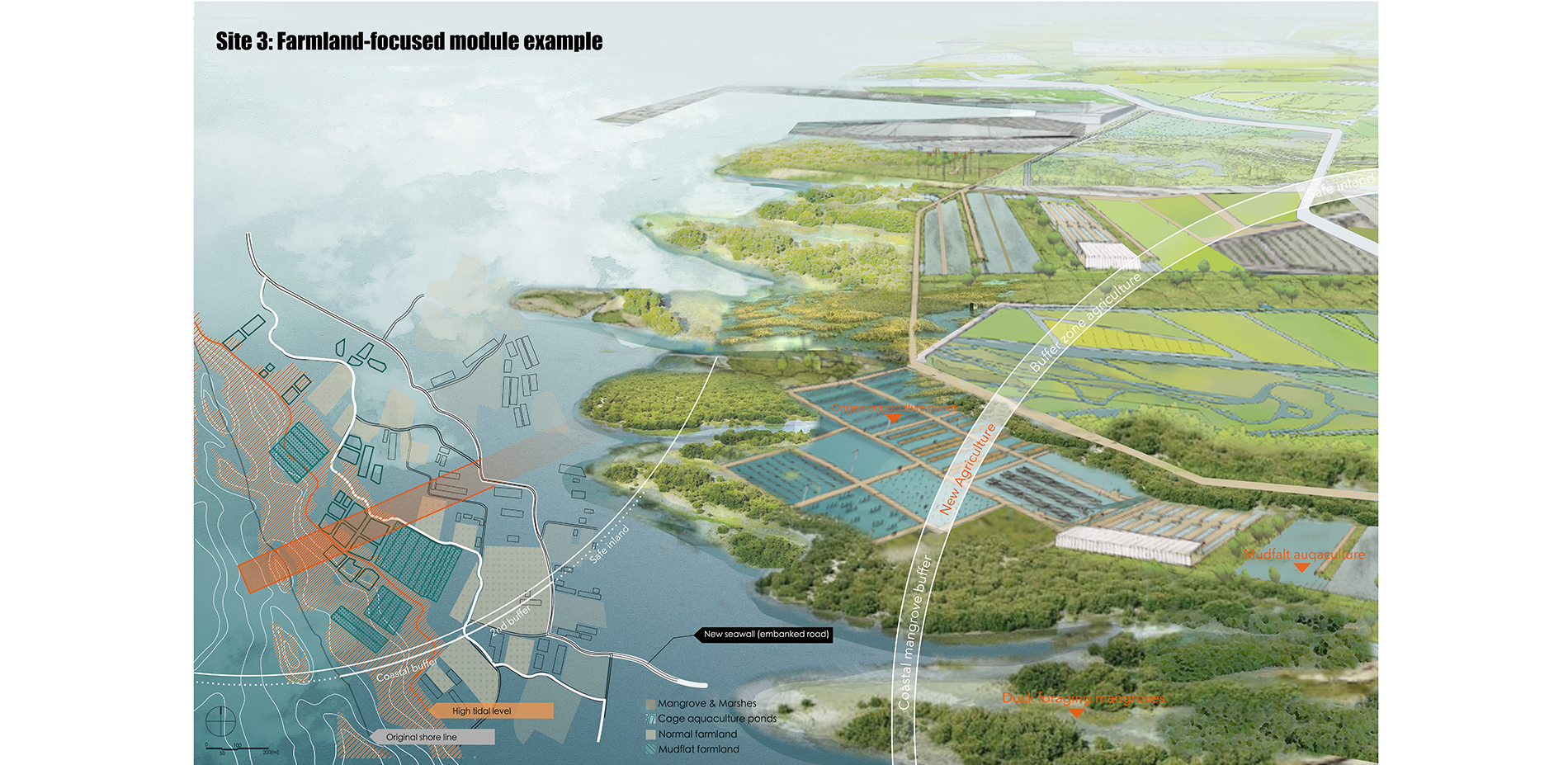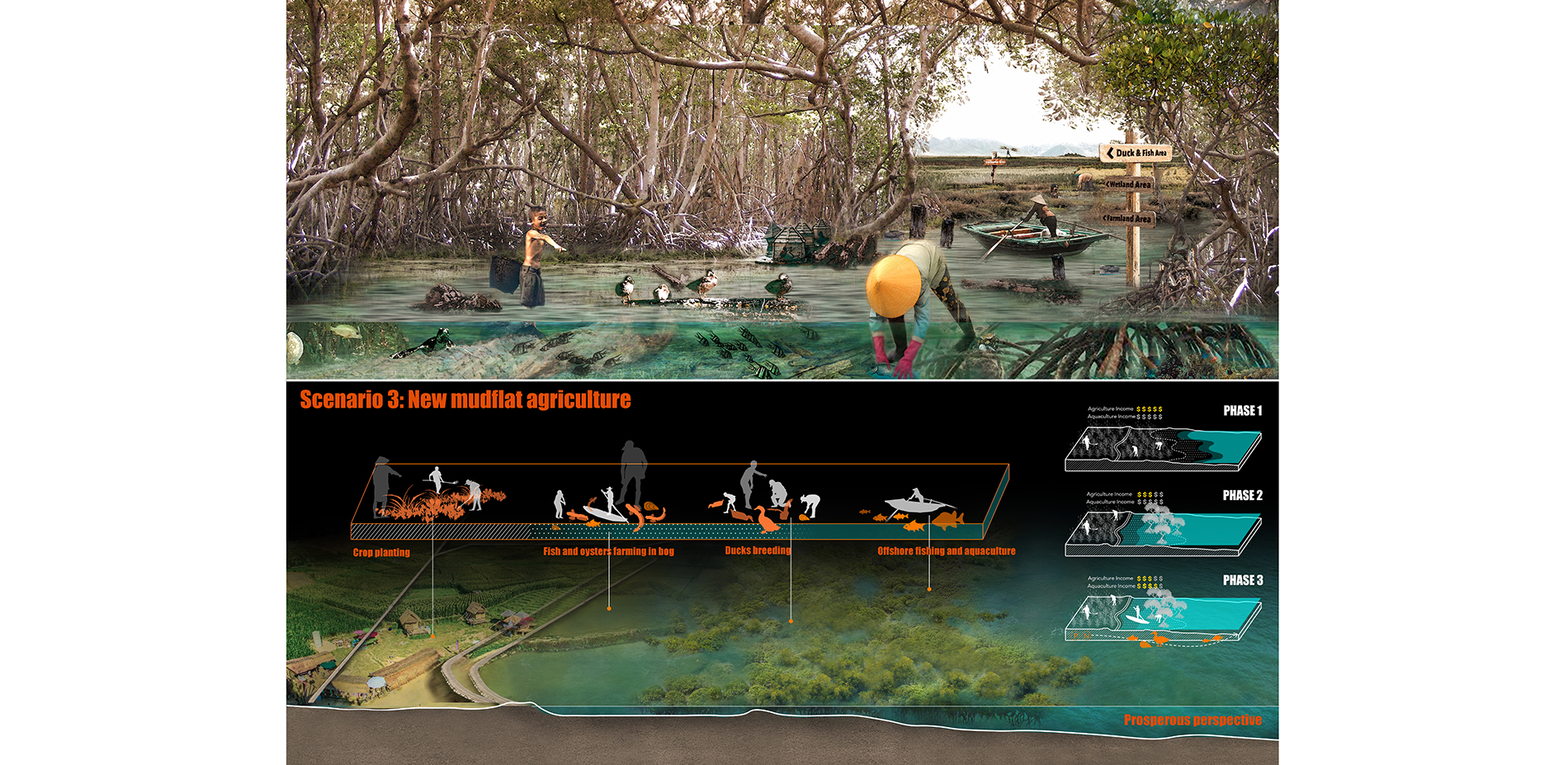Standing with Nature: Resilience Opportunities from Current, Sea-level Rise and Typhoon
Honor Award
Analysis and Planning
Wei Lei, Student International ASLA; Jiaxin Wen; Yinong Li; Yurong Xue; Shimin Zheng ; Tingting Li , Erke Zhang
Faculty Advisors: Jie He
Tianjin University, School of Architecture
Faced with increased storm intensity, climate change, and sea-level rise, the port city of Kaohsiung, Taiwan has armored itself with concrete around its central harbor. Where that armor ends, this study proposes an acceptance of rising waters in the form of planned retreat that transitions coastal land into a productive aquatic resource that will continue to sustain the region even after it is underwater. As sea walls submerge, they could become productive reefs, while softer buffers of mangroves would also protect inland resources. The predicted, gradual rise of sea levels allows for a phased approach toward maintaining a fertile, if more marine, coastline in the coming decades.
- 2020 Awards Jury
Project Credits
Lecturer, project advisor
ZHAO Wei
Professor, Landscape Architecture Program Director
CAO Lei
Project Statement
Human beings can build concrete armour at any cost to protect them from the sea, but not for everywhere. Titled ‘Standing with Nature’, the concept challenges those that have often been understood as disastrous natural effects, and proposed a special way to take the advantage of nature to save the dying fringe coastal area of Kaohsiung, which is away from the port-centred prosperous metropolitan area well protected by giant concrete land-fill ports. This project sees the special endemic opportunities from current, sea-level rise and typhoon in restoration of the destructively damaged coastal mangrove habitat. With the voluntary regress caused by the gradual sea-level rise, such succession process leaves space for natural force and low-impact human intervention. By creating a forward biophilic landscape buffer along with death and life both for men and nature, a general coastal resilience is supposed to be promoted together with the permaculture development within and beyond the coast to meet a common prosperity at the currently declining coastal fringe.
Project Narrative
Background/ Problem Statement
Sea-level rise, extreme weather, together with economic downturn in the process of the industrial transformation, are common challenges to most coastal regions worldwide. To continue building artificial seawalls and reclaiming the land from the sea might solve such concerns directly. However, in the long run, it will make the construction and maintenance prohibitively expensive or simply impossible. Kaohsiung is facing decreased growth of various dominant industries that used to create the prosperity of the city. The coast of Kaohsiung City is still in land reclamation construction, while the fringe coast of Kaohsiung is in the situation of declining small ports, traditional farmland, inland vast aquiculture, and shanty towns. Rebuilding the exceedingly high cost seawalls to bear the rising damage of extreme weather is a plausible but neither necessary or preferable choice for the fringe area.
Many regions worldwide, rich or poor, have applied mangrove restoration as a generally acknowledged method for coastal safety upgrade. Kaohsiung used to be the habitat of 5 mangrove species, however, due to the mass construction since colonization, the mangrove loss is even higher than the global 35% loss during the 20th century. Especially, with the construction of Kaohsiung Port and Cijin Harbour, the main original habitat of 2 species Rhizophora mucronata Poir. and Ceriops tagal (Perr.) C. B. Rob. are permanently destroyed and never came back due to the hardened shore. The mangrove not only works as a strong natural buffer, but also enhances ecosystem. Moreover, the mangrove is the vegetation that has the highest carbon storage. Considering that the key factor of sea-level rise and extreme weather is the global warming caused by carbon emission, the global restoration of mangroves is more than a mere natural buffer insertion for local safety. Whereas, how to encourage the mangrove restoration along the hardened fringe shoreline and promote a mangrove intervened sustainable development to enhance this decades-long process in consideration of the special fringe situation is what this project focuses on.
A Fringe Strategic View: endemic opportunities from crisis
Considering the limited economic contribution and land utilization of the fringe, how to protect the fringe area in a feasible way is a key issue. The very view of rethinking the fringe differently from normal urban area is where the strategies stem from: instead of directly solving the problems, fringe areas lack both funding support and human resources. Our strategies look at both side of a coin to rethink the role of those that often been understood as misfortunes.
• Ocean current & Typhoon:
Ocean current and typhoon often bring obstacles to the shore that not only impede the functioning of ports and ships, but also require great human resources to clear them from time to time. However, against the background of deindustrialization, sedimentation, marine creatures, drifts, seeds that current and typhoon bring to the shore are beneficial to ecological restoration in abandoned or less-used areas.
• Rising sea-level:
Rising sea-level will endanger the communities by the sea, but at the same time redefine the current sea-walls by submersion. With a voluntary/unavoidable recession, the submerged land caused by sea-level rise will gradually transform into a new subtidal zone and leave space for new lives that cannot stand the former concrete shore.
• Mangrove:
The Mangrove is an aggressive species for marshes and obstacle to offshore activities. However, with strong adaptability to subtidal zone, the mangrove has turned to be an ideal species that can sprawl onto the artificial coastal surface with limited sediments.
• Shrinking Fishery:
Fishery, including inland aquaculture, offshore floating aquaculture and fishing, is declining currently. While chances are that aquaculture causes eutrophication that can provides extra nutrients for coastal wild creatures.
• Hard buffer:
Hard buffer currently is a barrier to coastal creatures though weakening waves efficiently. Restoring a new biophilic and soft buffer like mangrove, mussel cages together with the current seawall will benefit both man and nature.
• Declining community:
Industrial shrinking, population lost, old infrastructures are all challenges to the community in the face of sea-level rise and typhoon. With less demand for land, such suburban area might be the only area that could return land to nature and establish a permaculture relationship.
Through the analysis of the fringe area, we found special opportunities for Kaohsiung and worked out possible biophilic strategies from the ocean current and typhoon, which is taken advantage of and centred in our plan.
• Scientists have tracked the drifts caused by ocean current from Southeast Asia to Taiwan Strait. These drifts includes the two once extinct Kaohsiung mangrove species, together with many other coastal plants and marine animals. What Kaohsiung needs is a softer and fertile coast that can settle those travelling creatures.
• Statistics have shown that Kaohsiung is a zone with high sedimentation of driftwood especially after typhon. Though current policy of Kaohsiung is to clear all the driftwood, researches suggests great ecologic function of driftwood for the coast as well as off-shore ecosystem. Considering the current concrete coast that cannot sustain lives, driftwood in fringe coastal line may act as a pioneer climber, following which is sedimentation, decomposition and ecological succession.
Turning the Domino Effect: proposing a mangrove centred coastal transformation
Sea-level rise and typhoon are challenges to both man and nature. Mankind has to recede if there is no seawall, while marine creatures have to go forward to find their ecological niches where they can get enough light for photosynthesis to survive. Moreover, species like coral and sea grass need sediment created by the dying communities to grow onto a new place. Such process can be explained by the Domino Effect——if one species doesn’t succeed in going forward, its various successors will be endangered. Driftwood and mangrove, as pioneer climbers, can ignite the whole forward process with the gradual rising sea-level.
The initial turning of the nature-centred Domino Effect relies on the human intervened natural process. The coastal fringe is classified by the seawall & breakwater type and the landuse behind. Typical modules of the current coastal buffer are considered within 4 succession phases under low-impact human intervention until they are fully submerged under water.
For the human-centred Domino Effect, since mangroves have different mutual relationship with current coastal human activities, not simply beneficial, once restored, the site beside the mangrove succession, and larger area nearby need to be reconsidered. The transformation within decades need to be more adaptive to and benefit from the new coast. Thus, beyond the typical modules, the general coast is considered as a whole in the face of submerged land and the mangrove buffer. The general relationship, both ecological and economical, is analysed and rearranged in terms of the current function to meet the criteria of mutual benefit to encourage the sustainability of such a long process.
As for our on-site design, three modules are selected as example considering their risk of submersion and current landuse. Scenarios of village, aquaculture farmland and agriculture farmland that take up more than 90% of current coastal fringe are picked to further illustrate what is a possible ideal relationship between mangroves and areas beyond the mere coast and how mankind could take the advantage of nature in the far future.
Perspective
From the vision of a community of shared future for mankind, we need to be aware that either the government or the communities might have very limited ability to resolve the conflicts between man and nature as they used to. Although not every coastal city has such special endemic opportunities like Kaohsiung to be a spot with high sedimentation that brings seeds and driftwood, there must be a piece of turning ‘Domino Card’ that landscape practitioners can find to stand with nature and be blessed with opportunities.

